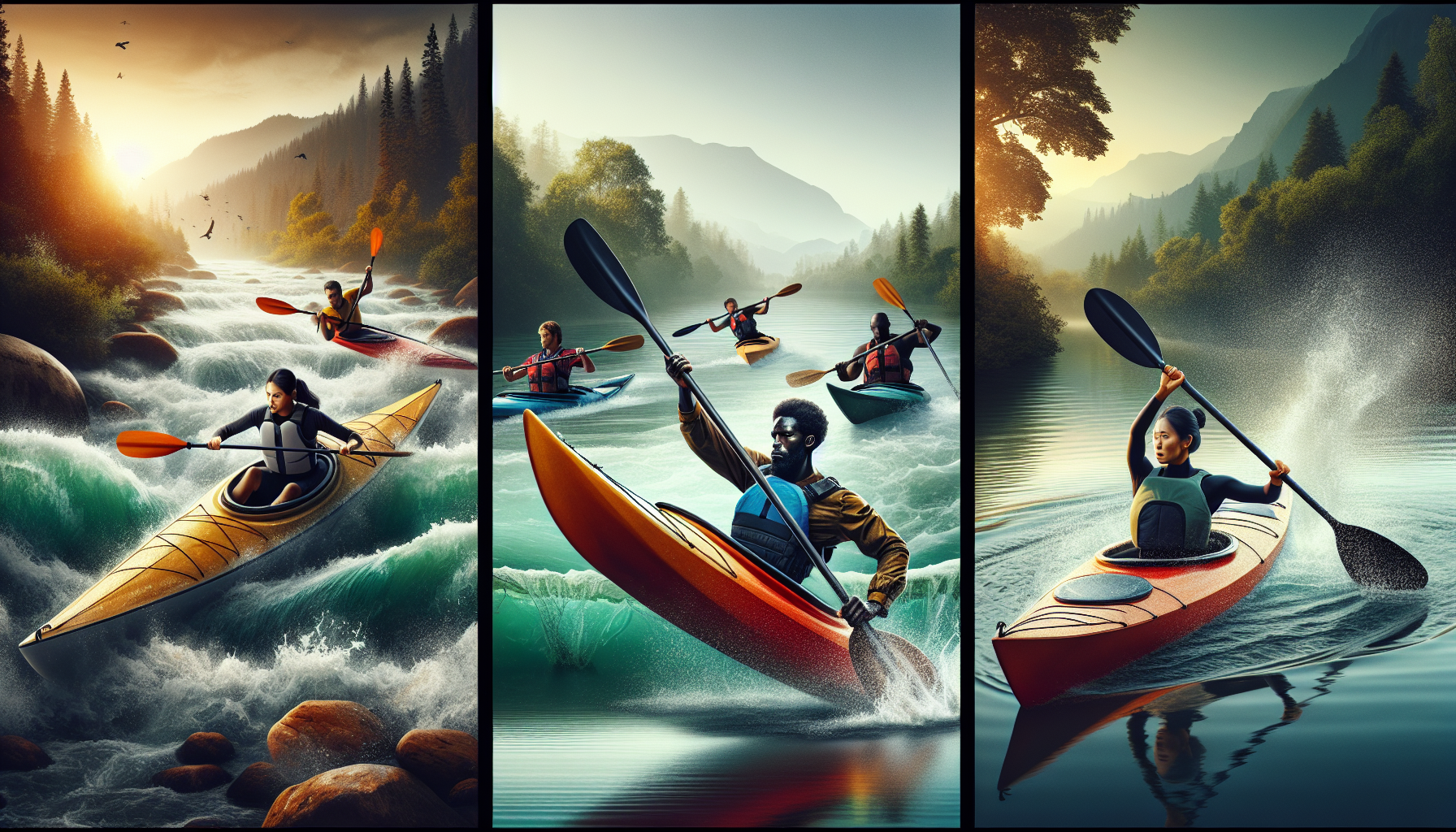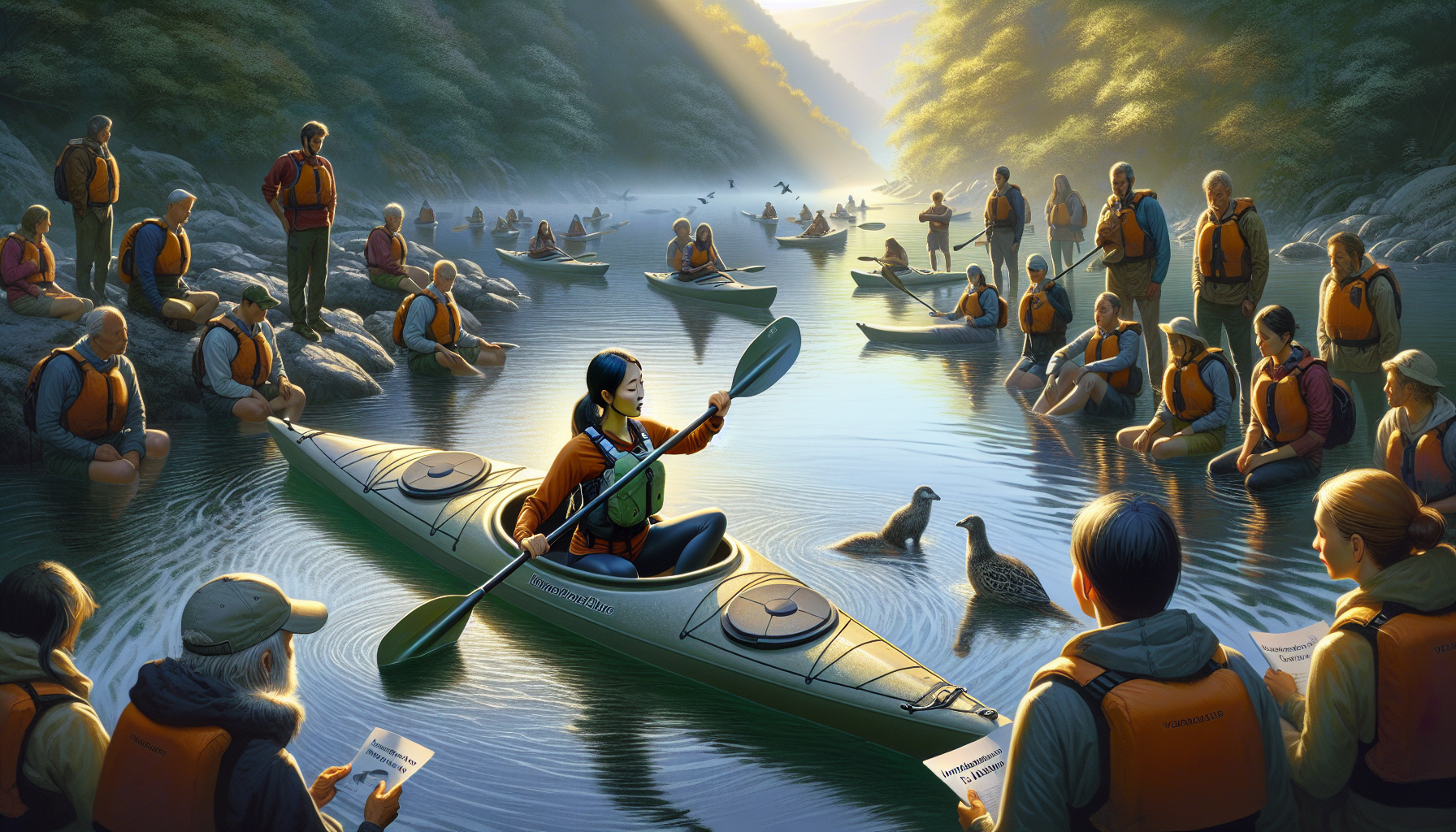

Introduction to Kayaking
History of kayaking
Kayaking is a water sport with a rich history that dates back thousands of years. It originated from the indigenous people living in the Arctic regions, who used kayaks for hunting and transportation in harsh environments. The word “kayak” itself comes from the Inuit language, meaning “hunter’s boat.”
Kayaking gained popularity in the late 19th and early 20th centuries, particularly in Europe and North America, as a recreational and competitive activity. It has since evolved into various disciplines, including whitewater kayaking, sea kayaking, and touring kayaking.
Benefits of kayaking
Kayaking offers numerous physical, mental, and emotional benefits. It is a full-body workout that strengthens the muscles in your arms, back, shoulders, and core. The repetitive paddling motion also helps improve cardiovascular fitness and endurance.
Add to that the serene and peaceful experience of being out on the water, surrounded by nature’s beauty. Kayaking provides an opportunity to disconnect from the stresses of daily life and find solace in the tranquility of the water.
Moreover, kayaking allows you to explore and access remote areas that may be otherwise inaccessible 스마트폰-케이스-top-10-2023-가성비-갑-best-10. It gives you a chance to observe wildlife from a close distance and appreciate the natural environment.
Whether you’re seeking adventure, relaxation, or a way to stay fit, kayaking has something to offer for everyone.
Essential Kayaking Gear
Kayak
The first step in kayaking is choosing the right kayak. There are different types and sizes of kayaks available, each designed for specific environments and skill levels. A recreational kayak is a good option for beginners as it offers stability and ease of use. Whitewater kayaks, on the other hand, are designed to handle rapid currents and maneuver through challenging obstacles.
When selecting a kayak, consider factors such as your intended use, skill level, and the type of waters you’ll be paddling in. It’s also important to ensure that the kayak is the right size for your height and weight for optimal comfort and control.
Paddle
The paddle is your main tool for propelling the kayak forward. It’s crucial to choose a paddle that suits your height, the width of your kayak, and the type of kayaking you’ll be doing. The length of the paddle is an important consideration, and a general rule of thumb is that the paddle should be slightly longer than your height.
The material of the paddle can vary, with options such as aluminum, fiberglass, or carbon fiber. Each material has its benefits and drawbacks in terms of weight, durability, and price.
Personal Flotation Device (PFD)
A PFD, also known as a life jacket, is an essential piece of safety gear for kayakers. It is designed to keep you afloat in case of an accidental capsize or a sudden immersion in water. PFDs come in different styles, including inflatable options, and should be chosen based on your weight, comfort, and the specific regulations of the area where you’ll be kayaking.
Helmet
While not always necessary for all types of kayaking, a helmet is crucial for activities such as whitewater kayaking or paddling in rocky areas. It provides protection for your head in case of collisions with rocks or underwater hazards.
Spray Skirt
A spray skirt is a waterproof accessory that attaches to the cockpit of the kayak, creating a seal between the paddler and the water. It helps keep water out of the cockpit and your lower body dry, especially in rough water conditions or when encountering waves.
Safety Whistle
A safety whistle is a small, lightweight device that helps attract attention in case of an emergency. It is a valuable tool for signaling for help or alerting nearby boaters about your presence on the water.
Here’s a summary of the essential kayaking gear:
| Essential Kayaking Gear | Description |
|---|---|
| Kayak | The main vessel for kayaking, available in various types and sizes. |
| Paddle | The tool used to propel the kayak forward, available in different lengths and materials. |
| Personal Flotation Device (PFD) | A life jacket designed to keep you afloat in case of emergencies. |
| Helmet | Provides head protection in challenging kayaking environments. |
| Spray Skirt | Attaches to the cockpit to keep water out and keep you dry. |
| Safety Whistle | A small device to attract attention in emergencies. |
Mastering Kayaking Techniques
Proper paddling technique
The key to efficient and effective kayaking lies in mastering the proper paddling technique. It involves using your core muscles and maintaining a good posture for stability and power.
Start by sitting up straight with your back aligned and your feet resting comfortably on the footrests. Hold the paddle with a firm grip, placing one hand on the upper part of the paddle shaft and the other hand lower down. As you paddle, engage your core muscles and rotate your torso with each stroke, using the power generated from your core and back, rather than just relying on your arms.
Remember to keep your elbows slightly bent, avoid gripping the paddle too tightly, and maintain a smooth and fluid motion throughout.
Basic strokes: forward, backward, sweep, draw, and brace
Mastering the basic strokes is essential for maneuvering and controlling your kayak effectively:
- Forward stroke: This is the fundamental stroke for propelling the kayak forward here. Start by inserting the paddle blade into the water near your feet, then pull it back along the side of the kayak, keeping it close to the boat as you rotate your torso.
- Backward stroke: To reverse your direction or slow down, use the backward stroke. Insert the paddle blade behind you and push it forward, away from the kayak.
- Sweep stroke: The sweep stroke is used for turning the kayak. With the paddle blade angled away from the kayak, sweep the paddle in a wide arc, initiating the turn by placing the blade near the bow or stern of the kayak.
- Draw stroke: The draw stroke helps you move the kayak sideways or towards you. With the paddle blade angled perpendicular to the kayak, place it in the water near the side of the kayak and pull it towards you.
- Brace stroke: The brace stroke is used to maintain balance and stability. Place the flat blade of the paddle on the water’s surface and press down to prevent tipping or to regain balance after leaning too far.
Practice these strokes in different conditions and gradually increase your proficiency and control.
Turning and maneuvering
Being able to turn and maneuver your kayak effectively is crucial for navigating different water conditions and obstacles. Use a combination of the basic strokes mentioned above to achieve the desired direction:
- To turn quickly or make a tight turn, use a combination of sweep strokes on one side, followed by forward strokes on the opposite side.
- To navigate narrow passages or obstacles, use draw strokes to move your kayak sideways.
- For sharper turns, engage your hips and shift your weight in the direction you want to turn.
- Practice these techniques in calm and controlled environments before attempting them in more challenging conditions.
Remember, mastering turning and maneuvering takes practice and experience. As you become more comfortable with your kayak and the water, you’ll develop a better sense of control and adaptability.
Safety Tips and Precautions
Choosing the right kayak for your skill level
One of the most important considerations for kayaking safety is choosing a kayak that matches your skill level. Always select a kayak that you feel comfortable and confident in. It’s better to start with a stable and easy-to-maneuver kayak, especially if you’re a beginner. As you gain experience and skill, you can progress to more advanced kayaks designed for specific environments.
Checking weather conditions
Before heading out on the water, it’s essential to check the weather conditions. Be aware of any strong winds, storms, or sudden changes in weather that may impact your kayaking experience. If unfavorable conditions are forecasted, it’s best to postpone your trip for another day.
Wearing appropriate clothing
Choosing the right clothing is crucial for comfort and safety while kayaking. Dress in layers to adapt to changing weather conditions. Avoid cotton clothing, as it retains moisture and can make you feel cold. Instead, opt for synthetic materials that wick away moisture and provide insulation. In colder conditions or when kayaking in icy waters, consider wearing a wetsuit or drysuit to protect yourself from hypothermia.
Practicing self-rescue techniques
While kayaking, it’s important to be prepared for unexpected situations. Practice self-rescue techniques such as re-entering your kayak after capsizing and performing basic paddle float rescues. Knowing these techniques will give you the confidence to handle emergencies and increase your safety on the water.
Knowing your limits
Understanding your personal capabilities and limitations is crucial for staying safe while kayaking. Don’t push yourself beyond your skill level or attempt challenging waters without proper training or experience. Be honest with yourself about your swimming ability, physical strength, and comfort level in different water conditions. It’s essential to know when to turn back or seek assistance when necessary.
Here are some safety tips and precautions for kayaking:
| Safety Tips and Precautions | Description |
|---|---|
| Choosing the right kayak for your skill level | Selecting a kayak that matches your skill level and progressively advancing as you gain experience. |
| Checking weather conditions | Being aware of the weather forecast and avoiding kayaking in unfavorable or dangerous conditions. |
| Wearing appropriate clothing | Dressing in layers and choosing moisture-wicking and insulating materials for comfort and safety. |
| Practicing self-rescue techniques | Learning and practicing techniques to re-enter your kayak and handle basic rescue scenarios. |
| Knowing your limits | Understanding your personal capabilities and boundaries, and avoiding situations that exceed your skill level. |
Common Mistakes to Avoid
Over gripping the paddle
One common mistake that beginners make is over gripping the paddle. Holding the paddle too tightly can lead to muscle fatigue and reduce your ability to perform efficient strokes. Instead, aim for a relaxed grip that allows you to maintain control while conserving energy.
Leaning too far back or forward
Your body posture plays a critical role in maintaining balance and stability on the water. Leaning too far back or forward can disrupt your equilibrium and increase the risk of capsizing. Keep your back straight and centered, distributing your weight evenly in the kayak. This will help you stay balanced and in control of your movements.
Not using torso rotation
Torso rotation is a fundamental aspect of efficient paddling. Many beginners rely solely on their arms for power, neglecting the power generated by rotating their torso. Engaging your core muscles and using torso rotation allows you to generate more power with less effort. Practice rotating your upper body with each stroke, and you’ll notice a significant improvement in your paddling technique.
Ignoring proper body posture
Proper body posture is essential for stability and control. Slouching or sitting hunched over can affect your balance and limit your ability to execute effective strokes. Sit up straight, keeping your shoulders back, and engage your core muscles for stability. Maintaining good posture will enhance your paddling performance and reduce strain on your body.
Neglecting equipment maintenance
Regular maintenance and inspections of your kayak and gear are vital for safety and longevity. Check your equipment before each outing, looking for any signs of wear or damage. Inspect your kayak for cracks or leaks, ensure that your paddle is in good condition, and check that your PFD fits properly and is functioning correctly. Taking care of your equipment will help prevent unexpected failures and ensure a safe and enjoyable kayaking experience.
